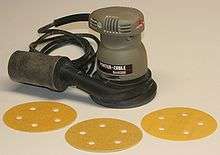Random orbital sander

Random orbit sanders are hand-held power tools for sanding in which the sanding blade delivers a random-orbit action. That is, the angle of rotation of the head and disk is variable. First introduced in 1982,[1] random orbit sanders combine the speed and aggressiveness of a belt sander with the ability to produce a finer finish than that available from a standard, slow speed orbital finishing sander.[2] Random orbital sanders generally come in three different types: electric powered, air powered, and orbital floor sanders. The electric and air powered orbital sanders are handheld, while the floor orbital sanders are large machines that roll.
The random orbit sanding pattern is produced by simultaneously spinning the sanding disk and moving it in small ellipses. This ensures that no single part of the abrasive material travels the same path twice during the same rotation. Because of this random sanding action, the tool does not leave swirl marks, and is not sensitive to the direction of the wood grain.[2] This makes it useful when sanding two pieces of wood that will be fastened at right angles. Random-orbital sanders use sandpaper disks, and many include integrated dust collectors. Disks are attached using either pressure-sensitive adhesives or a hook and loop system. On models equipped with a dust collection feature, a vacuum sucks discharged dust through holes in the paper and pad, feeding it to a bag, shop vac, or canister.
References
- ↑ "How to Use an Orbital Sander". The Geek Pub. Retrieved 5 October 2015.
- 1 2 Joseph Truini (October 2, 2012). "Know Your Power Sanders, And How to Use Them". Popular Mechanics. Retrieved 2015-09-14.
External links
- "Choosing a Random Orbital Sander" by John C. Harris
- "How to Use Orbital Sander" by Morton Turner